|
|
|

|
|
2022 (vol. 22)
|
|
New larger benthic foraminifera from the subsurface Lower
to Middle Eocene Oldsmar Formation of southeastern Florida (USA)
Edward ROBINSON & Kevin J. CUNNINGHAM
| HTML  | PDF
| PDF  [3,071 KB]
| DOI: 10.2110/carnets.2022.2221
[3,071 KB]
| DOI: 10.2110/carnets.2022.2221
|
|
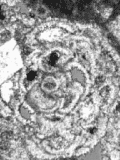 Abstract: We describe two larger benthic foraminiferal taxa collected from wells drilled in the subsurface Eocene rocks of southeastern Florida that are new to peninsular Florida and the Caribbean region. Saudia floridana
n.sp. is characteristic of a foraminiferal assemblage, along with Helicostegina gyralis, wide forms of the Cushmania americana group, and Gunteria floridana, in an upper part of the Oldsmar Formation. Globogypsinoides browardensis
n.gen. n.sp. occurs in a second foraminiferal assemblage, along with Borelis cf. floridanus, Coskinolina cf. yucatanensis, and as-yet undescribed large
rotaliids, in a middle part of the Oldsmar Formation. The foraminiferal assemblage of the middle Oldsmar unit is
ascribed an Ypresian age and the assemblage of the upper Oldsmar unit a Lutetian age. These two assemblages indicate inner shelf water depths of 40 m or less on the Florida Platform during the Early to Middle Eocene deposition of the middle to upper part of the Oldsmar Formation. Abstract: We describe two larger benthic foraminiferal taxa collected from wells drilled in the subsurface Eocene rocks of southeastern Florida that are new to peninsular Florida and the Caribbean region. Saudia floridana
n.sp. is characteristic of a foraminiferal assemblage, along with Helicostegina gyralis, wide forms of the Cushmania americana group, and Gunteria floridana, in an upper part of the Oldsmar Formation. Globogypsinoides browardensis
n.gen. n.sp. occurs in a second foraminiferal assemblage, along with Borelis cf. floridanus, Coskinolina cf. yucatanensis, and as-yet undescribed large
rotaliids, in a middle part of the Oldsmar Formation. The foraminiferal assemblage of the middle Oldsmar unit is
ascribed an Ypresian age and the assemblage of the upper Oldsmar unit a Lutetian age. These two assemblages indicate inner shelf water depths of 40 m or less on the Florida Platform during the Early to Middle Eocene deposition of the middle to upper part of the Oldsmar Formation.
|
|
Carnets Geol., vol. 22, no. 21, p. 857-865
Online since December 25, 2022
|
|
Nomenclatural Note, p.
866
|
|
Just a different place to graze? An unusual occurrence of the echinoid
feeding trace Gnathichnus pentax on a marine vertebrate coprolite (Miocene,
Italy) and its palaeoethological implications
Alberto COLLARETA, Emanuele PERI, Stephen J. GODFREY & Giovanni BIANUCCI
| HTML  | PDF
| PDF  [3,071 KB]
| DOI: 10.2110/carnets.2022.2220
[3,071 KB]
| DOI: 10.2110/carnets.2022.2220
|
|
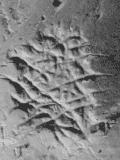 Abstract: Faeces produced by marine vertebrates and
macro-invertebrates contain sufficient organic matter to represent a usable food
source for a wide array of macroscopic animals. In some extant marine
environments, coprophagy even represents a crucial trophic interaction in food
webs. In ancient ecosystems, coprophagy by macroscopic animals is occasionally
exemplified by coprolites that exhibit biting traces or burrows. Here, we report
Gnathichnus pentax on an exquisitely preserved vertebrate-bitten vertebrate
coprolite from the marine calcareous deposits of the Pietra leccese (Miocene,
southern Italy). This unusual occurrence is interpreted as evidence of the
feeding activity of a regular echinoid; in particular, it may represent either
exploratory coprophagy or the browsing of an algal (microbial) film that locally
developed on the exterior of the faeces. Strengthening the former interpretation,
the development of microbial communities on submerged faeces often leads to
their destruction; furthermore, some extant Antarctic echinoderms are well known
to ordinarily feed on vertebrate faeces, and coprophagy is believed to be fairly
widespread among sea urchins. Supporting the algal browsing hypothesis, in turn,
only a limited area of the external surface of the faeces was subject to grazing,
and the resulting trace is neatly defined, which suggest that the feeding sea
urchin targeted a precise location on the dung's exterior when the latter was
already rather firm. To our knowledge, the G. pentax
specimen studied here represents the first published record of this ichnotaxon
on a coprolite. Abstract: Faeces produced by marine vertebrates and
macro-invertebrates contain sufficient organic matter to represent a usable food
source for a wide array of macroscopic animals. In some extant marine
environments, coprophagy even represents a crucial trophic interaction in food
webs. In ancient ecosystems, coprophagy by macroscopic animals is occasionally
exemplified by coprolites that exhibit biting traces or burrows. Here, we report
Gnathichnus pentax on an exquisitely preserved vertebrate-bitten vertebrate
coprolite from the marine calcareous deposits of the Pietra leccese (Miocene,
southern Italy). This unusual occurrence is interpreted as evidence of the
feeding activity of a regular echinoid; in particular, it may represent either
exploratory coprophagy or the browsing of an algal (microbial) film that locally
developed on the exterior of the faeces. Strengthening the former interpretation,
the development of microbial communities on submerged faeces often leads to
their destruction; furthermore, some extant Antarctic echinoderms are well known
to ordinarily feed on vertebrate faeces, and coprophagy is believed to be fairly
widespread among sea urchins. Supporting the algal browsing hypothesis, in turn,
only a limited area of the external surface of the faeces was subject to grazing,
and the resulting trace is neatly defined, which suggest that the feeding sea
urchin targeted a precise location on the dung's exterior when the latter was
already rather firm. To our knowledge, the G. pentax
specimen studied here represents the first published record of this ichnotaxon
on a coprolite.
|
|
Carnets Geol., vol. 22, no. 20, p. 847-855
Online since December 25, 2022
|
|
Miocene-Holocene paleoenvironmental changes in the Tinto River estuary (SW Spain) evidenced by
sedimentology, geochemistry and fauna
Manuel ABAD, Marta ARROYO, Francisco RUIZ, María Luz GONZÁLEZ-REGALADO, Joaquín RODRÍGUEZ VIDAL, Luis Miguel CÁCERES, Tatiana IZQUIERDO, Antonio TOSCANO, Paula GÓMEZ, Gabriel GÓMEZ & Verónica ROMERO
| HTML  | PDF
| PDF  [3,071 KB]
| DOI: 10.2110/carnets.2022.2219
[3,071 KB]
| DOI: 10.2110/carnets.2022.2219
|
|
 Abstract: This
paper investigates the paleoenvironmental evolution of a long core extracted in
a small cove located in the Tinto-Odiel estuary (SW Spain). The
inferred reconstruction is supported by sedimentological, geochemical,
paleontological data and dating. Seven phases have been identified, with the transit
from Late Neogene marine environments to a subrecent freshwater pond and
a final anthropic filling. On the basis of these data, this area was flooded during
the maximum of the MIS-1 transgression (6.5-5.2 cal. kyr BP), with the temporary
presence of a subtidal channel with phanerogam meadows. During this evolution,
three geochemical peaks have been detected, which correspond to 1) the first
evidence of mining activities (~4.5 cal. kyr BP), 2) an interval of intensive
mining (1850-1960) and 3) an industrial period (1966-1985), affected by the dumping of highly polluting waste into this estuary. Abstract: This
paper investigates the paleoenvironmental evolution of a long core extracted in
a small cove located in the Tinto-Odiel estuary (SW Spain). The
inferred reconstruction is supported by sedimentological, geochemical,
paleontological data and dating. Seven phases have been identified, with the transit
from Late Neogene marine environments to a subrecent freshwater pond and
a final anthropic filling. On the basis of these data, this area was flooded during
the maximum of the MIS-1 transgression (6.5-5.2 cal. kyr BP), with the temporary
presence of a subtidal channel with phanerogam meadows. During this evolution,
three geochemical peaks have been detected, which correspond to 1) the first
evidence of mining activities (~4.5 cal. kyr BP), 2) an interval of intensive
mining (1850-1960) and 3) an industrial period (1966-1985), affected by the dumping of highly polluting waste into this estuary.
|
|
Carnets Geol., vol. 22, no. 19, p. 825-845
Online since December 25, 2022
|
|
Pliocene bivalves (Pteriomorphia) of Algiers Sahel (Algeria): Systematics and palaeoecology
Sabiha TALMAT, Madani BENYOUCEF, Bruno FERRÉ, Sabrina BOUZEGUELLA & Fatma-Zohra OUCHENE
| HTML  | PDF
| PDF  [3,071 KB]
| DOI: 10.2110/carnets.2022.2218
[3,071 KB]
| DOI: 10.2110/carnets.2022.2218
|
|
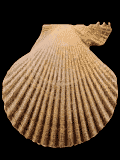 Abstract: A hundred specimens of pteriomorph bivalves
were collected from the marine deposits of the marly-sandy formations of Algiers
Sahel, which correspond to transitional facies between the Piacenzian deep marly
deposits and the Astian molassic deposits. They are herein analysed from a
systematic, taphonomic, palaeoecological and paleoenvironmental point of view.
The preliminary inventory list consists of 27 species belonging to eight
families: Arcidae, Nuculidae, Glycymeridae, Spondylidae, Pectinidae,
Plicatulidae, Gryphaeidae, and Ostreidae. Two sedimentary units with different
bivalve biodiversity are recognized: the first: a shallow infralittoral unit
characterised by large Flabellipecten alessii, Aequipecten angelonii,
Ostrea lamellosa and O. edulis; the second: A deeper unit of
circalittoral environment mainly includes Amusium cristatum. These
bivalve shells display sclerobiont traces. Bioerosion traces are mostly
assignable to clionid sponges (Entobia isp.), polychaete worms (Maeandropolydora
isp. and Caulostrepsis isp.), bivalves (Gastrochaenolites isp.)
and predatory gastropods (Oichnus isp.). Identified encrusting organisms
are juvenile oyster shells, cirripedes, polychaete worms (serpulids), and
indeterminate bryozoans. Analysis of boring and encrusting traces indicate a
progressive environmental change from a relative high energy setting to a lower
energy and deeper water setting, and correspond to a shallow sea with
well-oxygenated waters. Abstract: A hundred specimens of pteriomorph bivalves
were collected from the marine deposits of the marly-sandy formations of Algiers
Sahel, which correspond to transitional facies between the Piacenzian deep marly
deposits and the Astian molassic deposits. They are herein analysed from a
systematic, taphonomic, palaeoecological and paleoenvironmental point of view.
The preliminary inventory list consists of 27 species belonging to eight
families: Arcidae, Nuculidae, Glycymeridae, Spondylidae, Pectinidae,
Plicatulidae, Gryphaeidae, and Ostreidae. Two sedimentary units with different
bivalve biodiversity are recognized: the first: a shallow infralittoral unit
characterised by large Flabellipecten alessii, Aequipecten angelonii,
Ostrea lamellosa and O. edulis; the second: A deeper unit of
circalittoral environment mainly includes Amusium cristatum. These
bivalve shells display sclerobiont traces. Bioerosion traces are mostly
assignable to clionid sponges (Entobia isp.), polychaete worms (Maeandropolydora
isp. and Caulostrepsis isp.), bivalves (Gastrochaenolites isp.)
and predatory gastropods (Oichnus isp.). Identified encrusting organisms
are juvenile oyster shells, cirripedes, polychaete worms (serpulids), and
indeterminate bryozoans. Analysis of boring and encrusting traces indicate a
progressive environmental change from a relative high energy setting to a lower
energy and deeper water setting, and correspond to a shallow sea with
well-oxygenated waters.
|
|
Carnets Geol., vol. 22, no. 18, p. 795-824
Online since December 25, 2022
|
|
Calcareous nannofossils of the uppermost Bedoulian and lower Gargasian of La Tuilière - St-Saturnin-lès-Apt (area of the Aptian stratotype, Vaucluse, SE France)
Bernard C. LAMBERT
| HTML  | PDF
| PDF  [3,071 KB]
| DOI: 10.2110/carnets.2022.2217
[3,071 KB]
| DOI: 10.2110/carnets.2022.2217
|
|
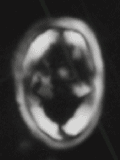 Abstract: An 148 m composite section located in the Gargas area
stratotype in southeastern France has been studied for its calcareous
nannofossil content. The four sections span the upper Bedoulian to lower
Gargasian with the stadial boundary located within the basal section south of
the village of Clavaillan. A total of 75 samples was processed to inventory
taxonomy and stratigraphic distributions. Abstract: An 148 m composite section located in the Gargas area
stratotype in southeastern France has been studied for its calcareous
nannofossil content. The four sections span the upper Bedoulian to lower
Gargasian with the stadial boundary located within the basal section south of
the village of Clavaillan. A total of 75 samples was processed to inventory
taxonomy and stratigraphic distributions.
Eprolithus floralis is present at the base of the stratigraphic succession. The lowest
occurrence of this species, which marks the base of Subzone NC7A, has been
documented in the uppermost lower Aptian (Bedoulian) in other sections in
southeastern France. The highest occurrence of the genus Micrantholithus
has been utilized to delineate the base of Subzone NC7B. This subzonal boundary
was placed at 48 m in the Les Gays I section (113.5 m in the composite) below
the lowest occurrence of the foraminifer Globigerinelloides
ferreolensis in the suprajacent sample (50 m). The lowest
occurrence of Braarudosphaera africana
is identified as a regional biohorizon in lower Subzone NC7A and a local proxy
for the Bedoulian/Gargasian boundary. This event was placed at 15.5 m in the
Clavaillan section at the base of the Dufrenoyia furcata Zone and within the
"Niveau Blanc inférieur" marker bed (NB1).
The genus Nannoconus is abundant to very
abundant in all samples examined. Taxonomic rigor has resulted in the
recognition of five main morphologic groups (A-E), including all but one of the
15 species discriminated over this relatively short stratigraphic interval. Four
main Nannoconus assemblage biozones - with one subdivision - have been
distinguished through semi-quantitative analyses and organized relative to these
taxonomic groupings. Assemblage Biozone B is restricted to the Bedoulian and has
been correlated to the lower portion of Subzone NC7A
(i.e., NC7A1). Assemblage biozones GI
and GII (A-B) have been correlated to the upper portion of Subzone NC7A
(i.e., NC7A2) and Biozone GIII to
Subzone NC7B within the Gargasian.
Assipetra is another solution-resistant genus included in semi-quantitative
analyses, where both its species were separated into small and large forms based
on a size of 10 μm. The highest percentages of large morphotypes are within
the Bedoulian in the lower 10.5 m of the Clavaillan section, roughly coeval to
an acme of large Assipetra observed in the basal portion of the Serre
Chaitieu section in the nearby Vocontian Basin.
|
|
Carnets Geol., vol. 22, no. 17, p. 745-793
Online since November 11, 2022
|
|
Palaeoentomological (fossil insects) outcrops in Lebanon
Sibelle MAKSOUD, Bruno R.C. GRANIER & Dany AZAR
| HTML  | PDF
| PDF  [7,133 KB]
| DOI: 10.2110/carnets.2022.2216
[7,133 KB]
| DOI: 10.2110/carnets.2022.2216
|
|
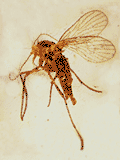 Abstract: With 35 Cretaceous outcrops yielding fossil
insects, either in amber or as rock (marls, limestones, cinerite, or dysodile)
impressions-compressions (adpressions), Lebanon has continuously contributed
significantly to the advance of palaeoentomology and to our understanding of
entomological evolution and palaeobiodiversity. Compared to its small surface
area, this country can be considered among the richest of fossil insect
outcrops. This is due to its geological history and mainly to its forest, fluvial -
lacustrine tropical and proximal marine subtropical palaeoenvironments plus
Peritethys equatorial and subequatorial palaeogeography during the Lower and
"Middle" Cretaceous. Herein, an exhaustive review of all outcrops with
insects is given. A list of all fossil insects described from Lebanon is
provided. Abstract: With 35 Cretaceous outcrops yielding fossil
insects, either in amber or as rock (marls, limestones, cinerite, or dysodile)
impressions-compressions (adpressions), Lebanon has continuously contributed
significantly to the advance of palaeoentomology and to our understanding of
entomological evolution and palaeobiodiversity. Compared to its small surface
area, this country can be considered among the richest of fossil insect
outcrops. This is due to its geological history and mainly to its forest, fluvial -
lacustrine tropical and proximal marine subtropical palaeoenvironments plus
Peritethys equatorial and subequatorial palaeogeography during the Lower and
"Middle" Cretaceous. Herein, an exhaustive review of all outcrops with
insects is given. A list of all fossil insects described from Lebanon is
provided.
|
|
Carnets Geol., vol. 22, no. 16, p. 699-743
Online since September 14, 2022
|
|
A new discoid heliolitid (Proporidae) from the Upper Ordovician of the Baltic area: Morphology and modalities of increase
Yves PLUSQUELLEC, Jaap EYZENGA & Percy S.F. van KEULEN
| HTML  | PDF
| PDF  [1,242 KB]
| DOI: 10.2110/carnets.2022.2215
[1,242 KB]
| DOI: 10.2110/carnets.2022.2215
|
|
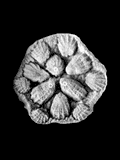 Abstract: A species of Proporidae (Heliolitida) forming very small, discoid coralla, is fully described. It is mainly preserved in natural moulds in the Öjlemyr chert, an erratic silicified limestone found in Eridanos deposits surfacing in the west and north-east of the Dutch Overijssel-province and adjoining German area, generally accepted to be Uppermost Katian. The material is assigned to the rehabilitated
Pinacopora Nicholson & Etheridge,
1878, a genus closely allied to
Propora Milne-Edwards & Haime, 1849, and a new species,
Pinacopora baltica is named. The main feature of this species, besides the characteristics of the genus and the biometric data, is the presence of wide, short, and convex septal ridges bearing scattered septal spines, alternating with narrow interseptal furrows. For the first time in heliolitids a pleurodictyoid pattern of growth is described. Only two species of
Pinacopora are recorded:
P. baltica n. sp. (Upper Ordovician) and
P. grayi Nicholson & Etheridge,
1878 (Lower Silurian), respectively from Baltica and Laurentia. Abstract: A species of Proporidae (Heliolitida) forming very small, discoid coralla, is fully described. It is mainly preserved in natural moulds in the Öjlemyr chert, an erratic silicified limestone found in Eridanos deposits surfacing in the west and north-east of the Dutch Overijssel-province and adjoining German area, generally accepted to be Uppermost Katian. The material is assigned to the rehabilitated
Pinacopora Nicholson & Etheridge,
1878, a genus closely allied to
Propora Milne-Edwards & Haime, 1849, and a new species,
Pinacopora baltica is named. The main feature of this species, besides the characteristics of the genus and the biometric data, is the presence of wide, short, and convex septal ridges bearing scattered septal spines, alternating with narrow interseptal furrows. For the first time in heliolitids a pleurodictyoid pattern of growth is described. Only two species of
Pinacopora are recorded:
P. baltica n. sp. (Upper Ordovician) and
P. grayi Nicholson & Etheridge,
1878 (Lower Silurian), respectively from Baltica and Laurentia.
|
|
Carnets Geol., vol. 22, no. 15, p. 685-698
Online since September 14, 2022
|
|
Nomenclatural Note, p.
684
|
|
Tethysian, Tethyan or ... Tethys Ocean and Tethys
Bruno GRANIER
| HTML  | PDF
| PDF  [125 KB]
| DOI: 10.2110/carnets.2022.22EN1 [125 KB]
| DOI: 10.2110/carnets.2022.22EN1
|
|
 Abstract: Tethys is a stand-alone modern noun, which does not require a qualifier in the English language. The use of the qualifiers Tethyan or Tethysian should be strongly discouraged. Taxa the names of which comprise the stem -tethy- are named after the Greek Goddess; those the names of which bear the stem -tethys- are named after the German (Suess, 1901), French (Suess, 1902) and English (Suess, 1908) Tethys Ocean. There was too much confusion on these two last points. Abstract: Tethys is a stand-alone modern noun, which does not require a qualifier in the English language. The use of the qualifiers Tethyan or Tethysian should be strongly discouraged. Taxa the names of which comprise the stem -tethy- are named after the Greek Goddess; those the names of which bear the stem -tethys- are named after the German (Suess, 1901), French (Suess, 1902) and English (Suess, 1908) Tethys Ocean. There was too much confusion on these two last points.
|
|
Thanks to our German-speaking readers (Olaf Elicki, Mike
Reich, Torsten Scheyer, Ekbert Seibertz, ...)
for having reported some grammatical errors: for instance, in the first
table, one should read "(die)
Tethys" instead of "(der) Tethys". [2022-08-12]
|
|
Carnets Geol., vol. 22, Editorial Note 1, p. 681-683
Online since August 10, 2022
|
|
The Lower Cretaceous Tuburan Limestone of Cebu Island, Philippines: Microfacies, micropalaeontology, biostratigraphy, and palaeogeographic perspectives
Jerali RODRIGO & Felix SCHLAGINTWEIT
| HTML  | PDF
| PDF  [4,570 KB]
| DOI: 10.2110/carnets.2022.2214 [4,570 KB]
| DOI: 10.2110/carnets.2022.2214
|
|
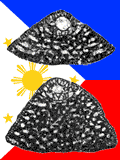 Abstract: The occurrence of orbitolinid-bearing shallow water limestone blocks
(Tuburan Limestone) incorporated into the volcanic series from
Cebu Island, Central Philippines, has been known since the 1950's. Taxonomic studies
including solid biostratigraphic data however are lacking or not substantiated.
Herein we report the occurrence of Mesorbitolina
texana (Roemer), transitional forms between M.
texana and M. subconcava (Leymerie),
Mesorbitolina birmanica (Sahni),
Palaeodictyoconus actinostoma Arnaud-Vanneau
& Schroeder, Neorbitolinopsis
conica (Matsumaru), Paracoskinolina
sp. and other benthic foraminifera (Akcaya,
Praechrysalidina, Vercorsella)
indicating a latest Aptian age. The previously accepted Late Albian age for the
Tuburan Limestone based on Neorbitolinopsis conulus (Douvillé) is rejected herein and
suggested as a misidentification with the recently revised Aptian - Lower Albian
Neorbitolinopsis conica (Matsumaru).
The general poverty of Lower Cretaceous dictyoconids in the Tuburan Limestone is
interpreted as being caused by the lack of suitable extensive lagoonal facies
that is generally typical for carbonate platforms of passive continental
margins.
The observed microfacies types instead refer to external platform margin
settings with corals, stromatoporoids, sclerosponges (e.g., Acanthochaetetes),
and planktic foraminifera. The recovered (micro) fauna from Cebu Island shows
striking similarities to assemblages reported from Western and Mid-Pacific
guyots but with indicated younger ages (up to the late Albian) based on data
that - in our opinion - do not stand up to close scrutiny. Finally, a model
is proposed interpreting the Tuburan Limestone from Cebu Island as remnants of a
former carbonate cover of a guyot that originated as a volcanic island in the
Western-Central Pacific, and later became incorporated into an accretionary
wedge/mélange zone due to subduction-collisional processes. Abstract: The occurrence of orbitolinid-bearing shallow water limestone blocks
(Tuburan Limestone) incorporated into the volcanic series from
Cebu Island, Central Philippines, has been known since the 1950's. Taxonomic studies
including solid biostratigraphic data however are lacking or not substantiated.
Herein we report the occurrence of Mesorbitolina
texana (Roemer), transitional forms between M.
texana and M. subconcava (Leymerie),
Mesorbitolina birmanica (Sahni),
Palaeodictyoconus actinostoma Arnaud-Vanneau
& Schroeder, Neorbitolinopsis
conica (Matsumaru), Paracoskinolina
sp. and other benthic foraminifera (Akcaya,
Praechrysalidina, Vercorsella)
indicating a latest Aptian age. The previously accepted Late Albian age for the
Tuburan Limestone based on Neorbitolinopsis conulus (Douvillé) is rejected herein and
suggested as a misidentification with the recently revised Aptian - Lower Albian
Neorbitolinopsis conica (Matsumaru).
The general poverty of Lower Cretaceous dictyoconids in the Tuburan Limestone is
interpreted as being caused by the lack of suitable extensive lagoonal facies
that is generally typical for carbonate platforms of passive continental
margins.
The observed microfacies types instead refer to external platform margin
settings with corals, stromatoporoids, sclerosponges (e.g., Acanthochaetetes),
and planktic foraminifera. The recovered (micro) fauna from Cebu Island shows
striking similarities to assemblages reported from Western and Mid-Pacific
guyots but with indicated younger ages (up to the late Albian) based on data
that - in our opinion - do not stand up to close scrutiny. Finally, a model
is proposed interpreting the Tuburan Limestone from Cebu Island as remnants of a
former carbonate cover of a guyot that originated as a volcanic island in the
Western-Central Pacific, and later became incorporated into an accretionary
wedge/mélange zone due to subduction-collisional processes.
|
|
Carnets Geol., vol. 22, no. 14, p. 631-679
Online since August 10, 2022
|
|
Tithonian-Hauterivian chronostratigraphy (latest Jurassic-Early Cretaceous), Mediterranean-Caucasian Subrealm and southern Andes: A stratigraphic experiment and Time Scale
Robert W. SCOTT
| HTML  | PDF
| PDF  [1,106 KB]
| DOI: 10.2110/carnets.2022.2213 [1,106 KB]
| DOI: 10.2110/carnets.2022.2213
|
|
 Abstract: New radioisotopic dates of Tithonian-Hauterivian strata in the Neuquén Basin
significantly recalibrate Early Cretaceous numerical ages. In order to evaluate
the implications of these revised ages, a graphic correlation experiment of
twenty-three Andean Tithonian to Hauterivian sections integrated the ranges of
254 species, sequence boundaries, polarity chrons, and radioisotopic ages that
compose the ANDESCS DB. This database accurately reproduces the order of Andean
ammonite zones and places them in a relative metric scale of a composite
reference section. The ranges in the ANDESCS DB were correlated with the LOK2016
DB that comprises Tithonian-Albian ammonites, calpionellids, nannofossils, and
polarity chrons in Mediterranean-Caucasian Subrealm stage reference sections. In
2017 these ranges were calibrated to GTS2016 mega-annums (MA). Although most Andean
ammonoids were endemic to the Indo-Pacific Subrealm, nannofossils, calpionellids
and polarity chrons were present in both areas. Abstract: New radioisotopic dates of Tithonian-Hauterivian strata in the Neuquén Basin
significantly recalibrate Early Cretaceous numerical ages. In order to evaluate
the implications of these revised ages, a graphic correlation experiment of
twenty-three Andean Tithonian to Hauterivian sections integrated the ranges of
254 species, sequence boundaries, polarity chrons, and radioisotopic ages that
compose the ANDESCS DB. This database accurately reproduces the order of Andean
ammonite zones and places them in a relative metric scale of a composite
reference section. The ranges in the ANDESCS DB were correlated with the LOK2016
DB that comprises Tithonian-Albian ammonites, calpionellids, nannofossils, and
polarity chrons in Mediterranean-Caucasian Subrealm stage reference sections. In
2017 these ranges were calibrated to GTS2016 mega-annums (MA). Although most Andean
ammonoids were endemic to the Indo-Pacific Subrealm, nannofossils, calpionellids
and polarity chrons were present in both areas.
This
stratigraphic experiment correlates base Berriasian as defined in France within
the Substeueroceras koeneni Zone. In Andean sections this boundary is
correlated with the Crassicolaria/Calpionella zone boundary dated at
about 141 Ma. The base of the Valanginian defined by Calpionellites
darderi correlates with the Neocomites wichmanni Zone of the
Neuquén Basin (NB) recalibrated at 139.50 Ma, which is confirmed by multiple
dates in Argentina, Mexico, Tibet, and elsewhere. The base Hauterivian
correlates with base of Holcoptychites neuquensis Zone in the NB
recalibrated at 131 Ma. Top of Hauterivian is in the Sabaudiella riverorum
Zone in the NB and is dated at 127 Ma below an unconformity.
Previous
cyclostratigraphic astrochronologic cycles are averaged and calibrate the
duration of the Tithonian at 5.67 myr, the Berriasian at 5.27 myr, the
Valanginian at 5.30 myr, and the Hauterivian at 5.60 myr. The age of each
stage is recalibrated by adding revised durations to the most common age of
base Valanginian of 139.5 Ma. These ages revise the Berriasian to Hauterivian
stages time scale, and the ages of stage boundaries are on average 2.8 myr
longer than proposed by the new Neuquén Basin radioisotopic dates.
|
|
Carnets Geol., vol. 22, no. 13, p. 619-660
Online since August 1, 2022
|
|
Priabonian non-geniculate coralline algae from the Central Carpathian Paleogene Basin
Juraj HRABOVSKÝ & Dušan STAREK
| HTML  | PDF
| PDF  [8,002 KB]
| DOI: 10.2110/carnets.2022.2212 [8,002 KB]
| DOI: 10.2110/carnets.2022.2212
|
|
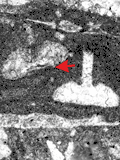 Abstract: Encrusting coralline algae are important rock-building organisms of the
lower Priabonian limestones from the Central Carpathian Paleogene Basin. Despite the effort of early palaeontologists, former classifications lacked many diagnostic characteristics and modern taxonomic concepts,
which hinders their use for modern palaeontological interpretations. The situation is further complicated as recent DNA analyses of extant coralline algae
highlight the limits of the morpho-anatomical classification and identify many coralline algal genera which can
also be recognized in the fossil record. Because palaeontology deals exclusively with the morpho-anatomical characteristics, a synthesis of the new discoveries in molecular phylogenetic analyses with morphology-based palaeontological classifications is necessary. Our palaeontological study based on published investigations on coralline molecular genetics enabled: 1)
the identification of seventeen coralline algal morphological species grouped in six genera: Sporolithon lugeonii, Sporolithon nummuliticum, Sporolithon
sp. 1, Sporolithon sp. 2, Lithothamnion camarasae, Lithothamnion cf. corallioides, Lithothamnion prascoi, Lithothamnion cf. ramosissimum, Lithothamnion roveretoi, Lithothamnion sp., Phymatolithon sp., Mesophyllum fructiferum, Mesophyllum cf. engelhartii, Mesophyllum sp., Chamberlainium lemoinei, Lithoporella melobesioides,
and Lithoporella cf. minus ; 2) the description of Chamberlainium lemoinei (Miranda) comb. nov. known from
the Bartonian, and 3) the identification of a unique encrusting coralline alga tentatively assigned to the genus Lithothamnion. Abstract: Encrusting coralline algae are important rock-building organisms of the
lower Priabonian limestones from the Central Carpathian Paleogene Basin. Despite the effort of early palaeontologists, former classifications lacked many diagnostic characteristics and modern taxonomic concepts,
which hinders their use for modern palaeontological interpretations. The situation is further complicated as recent DNA analyses of extant coralline algae
highlight the limits of the morpho-anatomical classification and identify many coralline algal genera which can
also be recognized in the fossil record. Because palaeontology deals exclusively with the morpho-anatomical characteristics, a synthesis of the new discoveries in molecular phylogenetic analyses with morphology-based palaeontological classifications is necessary. Our palaeontological study based on published investigations on coralline molecular genetics enabled: 1)
the identification of seventeen coralline algal morphological species grouped in six genera: Sporolithon lugeonii, Sporolithon nummuliticum, Sporolithon
sp. 1, Sporolithon sp. 2, Lithothamnion camarasae, Lithothamnion cf. corallioides, Lithothamnion prascoi, Lithothamnion cf. ramosissimum, Lithothamnion roveretoi, Lithothamnion sp., Phymatolithon sp., Mesophyllum fructiferum, Mesophyllum cf. engelhartii, Mesophyllum sp., Chamberlainium lemoinei, Lithoporella melobesioides,
and Lithoporella cf. minus ; 2) the description of Chamberlainium lemoinei (Miranda) comb. nov. known from
the Bartonian, and 3) the identification of a unique encrusting coralline alga tentatively assigned to the genus Lithothamnion.
|
|
Carnets Geol., vol. 22, no. 12, p. 567-617
Online since August 1, 2022
|
|
A larger benthic foraminiferal zonation for the Eocene of the Caribbean and central American region
Simon F. MITCHELL, Edward ROBINSON, Ercan ÖZCAN, Mark M. JIANG & Natalie ROBINSON
| HTML  | PDF
| PDF  [43,031 KB]
| DOI: 10.2110/carnets.2022.2211 [43,031 KB]
| DOI: 10.2110/carnets.2022.2211
|
|
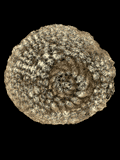 Abstract: We have undertaken a study of the larger benthic foraminifera
(LBF) of the Eocene of Jamaica that involved collecting free specimens and calibrating their occurrence against chronostratigraphy using calcareous nannofossils identified from sample splits or adjacent samples. The
results have been plotted stratigraphically and allow a detailed zonation of the Eocene (14 zones) to be developed based largely on lepidocyclinids and similar forms. The zonation can be shown to be applicable to the Americas extending from northern South America, to Central America, the Caribbean and southern North America. The LBF biostratigraphy is based on the evolution of various groups. Three zones are recognized in the
Ypresian, six zones in the Lutetian, three zones in the Bartonian, and two zones in the
Priabonian. In order to classify the LBF we have revised the important groups used for the zonation scheme that occur in the Eocene and figure numerous examples. Our revision rearranges described genera into evolutionary, monophyletic clades to which we give the hierarchy of family and subfamily. We provide remarks on published taxa explaining how they are recognized and describe all the new taxa (two families, one subfamily, four genera and five species). The following families, genera and species are new: Butterliniana gen.
nov., Helicosteginidae fam. nov., Helicostegina minor sp. nov., Helicostegina jamaicensis sp.
nov., Helicostegina jeannemairae sp. nov., Pseudolepidinidae fam. nov., Orbitoininae
subfam. nov., Planorbitoinella gen. nov., Polyorbitoinella gen.
nov., Polyorbitoinella lilyfieldensis sp. nov., Orbitoina wrighti sp.
nov., and Nephronummulites gen. nov. Abstract: We have undertaken a study of the larger benthic foraminifera
(LBF) of the Eocene of Jamaica that involved collecting free specimens and calibrating their occurrence against chronostratigraphy using calcareous nannofossils identified from sample splits or adjacent samples. The
results have been plotted stratigraphically and allow a detailed zonation of the Eocene (14 zones) to be developed based largely on lepidocyclinids and similar forms. The zonation can be shown to be applicable to the Americas extending from northern South America, to Central America, the Caribbean and southern North America. The LBF biostratigraphy is based on the evolution of various groups. Three zones are recognized in the
Ypresian, six zones in the Lutetian, three zones in the Bartonian, and two zones in the
Priabonian. In order to classify the LBF we have revised the important groups used for the zonation scheme that occur in the Eocene and figure numerous examples. Our revision rearranges described genera into evolutionary, monophyletic clades to which we give the hierarchy of family and subfamily. We provide remarks on published taxa explaining how they are recognized and describe all the new taxa (two families, one subfamily, four genera and five species). The following families, genera and species are new: Butterliniana gen.
nov., Helicosteginidae fam. nov., Helicostegina minor sp. nov., Helicostegina jamaicensis sp.
nov., Helicostegina jeannemairae sp. nov., Pseudolepidinidae fam. nov., Orbitoininae
subfam. nov., Planorbitoinella gen. nov., Polyorbitoinella gen.
nov., Polyorbitoinella lilyfieldensis sp. nov., Orbitoina wrighti sp.
nov., and Nephronummulites gen. nov.
|
|
Carnets Geol., vol. 22, no. 11, p. 409-565
Online since July 1, 2022
|
|
Nomenclatural Note, p.
566
|
|
Discussion of Laya et al. (2021), Dissolution of ooids in seawater-derived fluids - an example from Lower Permian re-sedimented carbonates, West Texas, USA [Sedimentology 68(6), 2671-2706]
Bruno R.C. GRANIER & Christopher G.St.C. KENDALL
| HTML  | PDF
| PDF  [5,065 KB]
| DOI: 10.2110/carnets.2022.2210 [5,065 KB]
| DOI: 10.2110/carnets.2022.2210
|
|
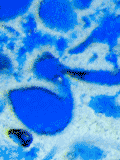 Abstract: This
discussion reassesses earlier interpretations of calcareous turbidites from the
subsurface Spraberry Formation of the Happy Field (Garza County, NW Texas). It is based on routine petrographic analyses
with a standard microscope. The succession of diagenetic products in this deep
water setting were a little initial cementation by low magnesian calcite (LMC)
and then the partial or complete leaching of both aragonite and high magnesian
calcite (HMC) allochems facilitated by the presence of a residual primary
intergranular porosity. This contradicts Laya et al.'s (2021)
claim that cementation left no residual intergranular porosity so further
leaching of the ooids would not have been possible. Instead the study made for
this discussion with the same thin sections found residual primary intergranular
porosity remains as evidenced by some of their photomicrographs. Most thin
sections with porous grainstones have 1) collapsed molds that exhibit evidence
of little initial cementation and 2) measured permeability values that range from some
mD to some tens of mD. Isopachous LMC cements occur in almost all thin sections
lining the margins of most intergranular pores. As these cements do not fully
fill the pores, there is permeable well-connected residual primary porosity with
no significant LMC cement in the secondary moldic porosity. Compaction affects
the allochems and, where these are partially leached, intergranular and moldic
porosities. Dissolution of aragonite (a major component) and HMC (possibly a
minor component) was probably not coeval. The order of paragenetic sequence of
this discussion study was: 1) LMC cementation; 2) aragonite leaching facilitated
by oxidation of the organic matter in the "biocrystals" of bioclasts
and oolitic cortices; 3) compactional brecciation, which was first mechanical,
and then chemical causing local collapse of the molds of some of the largest
pores. It was governed by cementation
initially in a shallow burial diagenetic setting and then leaching whereas
chemical compaction marks a slightly deeper burial diagenetic setting. The final
event was marked by oil migration into the Happy Field reservoirs, freezing the
calcium carbonate diagenesis. The theory of Laya et al. (2021) of
the leaching of ooids in directly "seawater-derived fluids" is unsupported by
the paragenetic sequence described above. Abstract: This
discussion reassesses earlier interpretations of calcareous turbidites from the
subsurface Spraberry Formation of the Happy Field (Garza County, NW Texas). It is based on routine petrographic analyses
with a standard microscope. The succession of diagenetic products in this deep
water setting were a little initial cementation by low magnesian calcite (LMC)
and then the partial or complete leaching of both aragonite and high magnesian
calcite (HMC) allochems facilitated by the presence of a residual primary
intergranular porosity. This contradicts Laya et al.'s (2021)
claim that cementation left no residual intergranular porosity so further
leaching of the ooids would not have been possible. Instead the study made for
this discussion with the same thin sections found residual primary intergranular
porosity remains as evidenced by some of their photomicrographs. Most thin
sections with porous grainstones have 1) collapsed molds that exhibit evidence
of little initial cementation and 2) measured permeability values that range from some
mD to some tens of mD. Isopachous LMC cements occur in almost all thin sections
lining the margins of most intergranular pores. As these cements do not fully
fill the pores, there is permeable well-connected residual primary porosity with
no significant LMC cement in the secondary moldic porosity. Compaction affects
the allochems and, where these are partially leached, intergranular and moldic
porosities. Dissolution of aragonite (a major component) and HMC (possibly a
minor component) was probably not coeval. The order of paragenetic sequence of
this discussion study was: 1) LMC cementation; 2) aragonite leaching facilitated
by oxidation of the organic matter in the "biocrystals" of bioclasts
and oolitic cortices; 3) compactional brecciation, which was first mechanical,
and then chemical causing local collapse of the molds of some of the largest
pores. It was governed by cementation
initially in a shallow burial diagenetic setting and then leaching whereas
chemical compaction marks a slightly deeper burial diagenetic setting. The final
event was marked by oil migration into the Happy Field reservoirs, freezing the
calcium carbonate diagenesis. The theory of Laya et al. (2021) of
the leaching of ooids in directly "seawater-derived fluids" is unsupported by
the paragenetic sequence described above.
|
|
Editorial notice:
Following
the reading of a paper authored by J.C. Laya et al. in the journal
Sedimentology, the authors submitted on 02-Nov-2021 a first discussion
manuscript based on analogues. On 09-Nov-2021, this first manuscript was
returned with harsh comments from three editors and ascribed the label "Reject
& Resubmit". On 07-Mar-2022, the first author (BRCG)
received a parcel with 40 thin sections to examine over a two weeks period. He
was charged significant import taxes for this "scientific material".
On 14-May-2022, the authors submitted a new discussion manuscript based on that
same material that was studied by J.C. Laya et al. On 07-Jun-2022
this second manuscript was ascribed the label "Immediate Reject"
without having any preliminary editorial reading. In the meantime, a claimant
allegedly accused the first author (BRCG) of "serious breaches in academic
publishing ethics" because he posted some photomicrographs of the material
on a social network. On 05-Apr-2022 and again on 18-May-2022, this claimant addressed
complains to the " Université
de Bretagne Occidentale", an action that may be characterised as slander or
defamation. Note that the authors were kindly granted the written permission to
publish this discussion paper and another paper by the legitimate owner of the
Happy Spraberry field, which also owns all material derived from any of their
materials (e.g., cores). It looks like there is no evidence that it was the case for the other parties.
|
|
Carnets Geol., vol. 22, no. 10, p. 395-408
Online since June 19, 2022
|
|
A rare ammonite assemblage in the Romaniceras ornatissimum Zone (Middle Turonian) from the Uchaux Massif, Vaucluse, France
Francis AMÉDRO, Cyril BAUDOUIN, Gérard DELANOY, Christian DEVALQUE & Francis ROBASZYNSKI
| HTML  | PDF
| PDF  [8,119 KB]
| DOI: 10.2110/carnets.2022.2209
[8,119 KB]
| DOI: 10.2110/carnets.2022.2209
|
|
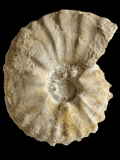 Abstract: The Uchaux Massif (Vaucluse, SE France) is one of the rare places in Europe where ammonites collecting can be led from a high middle Turonian through Late Turonian. That incited Alcide d'Orbigny in 1852 to quote Uchaux as "the French type of the Turonian stage" to complement the Saumur, Tourtenay, Montrichard and Tours localities mentionned in 1842 when the stage was created. In 2014, the monograph by Robaszynski et al. synthetized and actualized the informations available on the litho- and biostratigraphy of the Turonian from the Uchaux Massif. More recently, a new outcrop at Mondragon, in a place named Prés Morel, exposes the whole carbonate siltstones with Spongia of the Peyras Member (UL3). Were collected : Lewesiceras peramplum (Mantell, 1822), Romaniceras (Romaniceras) marigniacum Amédro & Châtelier, 2020, R. (Yubariceras) ornatissimum (Stoliczka, 1864), R. (Y.) kanei Jones, 1938, Collignoniceras woollgari regulare (Haas, 1946), C. carolinum (Orbigny, 1841), C. papale (Orbigny, 1841), C. turoniense (Orbigny, 1841) and a new species of Collignoniceras : C. rhodanicum Amédro, Baudouin & Delanoy sp. nov. This assemblage, unprecedented in the studied area, is characteristic of the Romaniceras ornatissimum
Zone which is the third of the four ammonite zones of the middle Turonian (Tm 3). At the top of this third zone, the surprise was to find the Romaniceras marigniacum bio-horizon defined in 2020 in the southern part of the Paris Basin at the top of the Tuffeau de Bourré and at the base of the Tuffeau Jaune de Touraine. Moreover, we now think that the Peyras Member has to be fully assigned to the Romaniceras ornatissimum
Zone. Lastly, the assemblage includes a rich population of Collignoniceras carolinum (24 specimens), the most important known to-day over the world. All these ammonites allow to know the spectrum of their morphological variations and show a dimorphism through the existence of micro- and macroconchs. Abstract: The Uchaux Massif (Vaucluse, SE France) is one of the rare places in Europe where ammonites collecting can be led from a high middle Turonian through Late Turonian. That incited Alcide d'Orbigny in 1852 to quote Uchaux as "the French type of the Turonian stage" to complement the Saumur, Tourtenay, Montrichard and Tours localities mentionned in 1842 when the stage was created. In 2014, the monograph by Robaszynski et al. synthetized and actualized the informations available on the litho- and biostratigraphy of the Turonian from the Uchaux Massif. More recently, a new outcrop at Mondragon, in a place named Prés Morel, exposes the whole carbonate siltstones with Spongia of the Peyras Member (UL3). Were collected : Lewesiceras peramplum (Mantell, 1822), Romaniceras (Romaniceras) marigniacum Amédro & Châtelier, 2020, R. (Yubariceras) ornatissimum (Stoliczka, 1864), R. (Y.) kanei Jones, 1938, Collignoniceras woollgari regulare (Haas, 1946), C. carolinum (Orbigny, 1841), C. papale (Orbigny, 1841), C. turoniense (Orbigny, 1841) and a new species of Collignoniceras : C. rhodanicum Amédro, Baudouin & Delanoy sp. nov. This assemblage, unprecedented in the studied area, is characteristic of the Romaniceras ornatissimum
Zone which is the third of the four ammonite zones of the middle Turonian (Tm 3). At the top of this third zone, the surprise was to find the Romaniceras marigniacum bio-horizon defined in 2020 in the southern part of the Paris Basin at the top of the Tuffeau de Bourré and at the base of the Tuffeau Jaune de Touraine. Moreover, we now think that the Peyras Member has to be fully assigned to the Romaniceras ornatissimum
Zone. Lastly, the assemblage includes a rich population of Collignoniceras carolinum (24 specimens), the most important known to-day over the world. All these ammonites allow to know the spectrum of their morphological variations and show a dimorphism through the existence of micro- and macroconchs.
|
|
Carnets Geol., vol. 22, no. 9, p. 333-393
Online since July 1, 2022
|
|
The Kalkowsky Project - Chapter IV. Case study of the Happy Spraberry oil reservoirs in NW Texas (with a micropaleontologic and biostratigraphic supplement): Collapsed molds should not be treated as a category of distorted ooids
Bruno R.C. GRANIER, Christopher G.St.C. KENDALL & Daniel VACHARD
| HTML  | PDF
| PDF  [6,180 KB]
| DOI: 10.2110/carnets.2022.2208 [6,180 KB]
| DOI: 10.2110/carnets.2022.2208
|
|
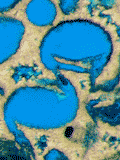 Abstract: The
subsurface upper Spraberry Formation in NW Texas is dominantly composed of
calcareous turbidites and debris-flows. The petrographic analysis of its porous grain-supported fabrics revealed the presence of
controversial superimposed compaction fabrics, sometimes referred to as "distorted
ooids". Based on the paragenetic sequence, it is demonstrated that these
allochems were not distorted. In fact, the related zigzag and silcrow (§) patterns
result from the collapse of molds, either oomolds or biomolds, in response to
mechanical compaction of the fragile framework made up of isopachous Low-Mg
Calcite cement surrounding these empty molds. As a side finding, this
stratigraphic unit, which was said to be late Kungurian in age, is proved to
be nearly 7 millions of year older. Abstract: The
subsurface upper Spraberry Formation in NW Texas is dominantly composed of
calcareous turbidites and debris-flows. The petrographic analysis of its porous grain-supported fabrics revealed the presence of
controversial superimposed compaction fabrics, sometimes referred to as "distorted
ooids". Based on the paragenetic sequence, it is demonstrated that these
allochems were not distorted. In fact, the related zigzag and silcrow (§) patterns
result from the collapse of molds, either oomolds or biomolds, in response to
mechanical compaction of the fragile framework made up of isopachous Low-Mg
Calcite cement surrounding these empty molds. As a side finding, this
stratigraphic unit, which was said to be late Kungurian in age, is proved to
be nearly 7 millions of year older.
|
|
Carnets Geol., vol. 22, no. 8, p. 311-332
Online since June 2, 2022
|
|
Taxonomy of the fossil calcareous algae: Revision of genera Physoporella Steinmann and Oligoporella Pia (Dasycladales)
Tonći GRGASOVIĆ
| HTML  | PDF
| PDF  [31,142 KB]
| DOI: 10.2110/carnets.2022.2207 [31,142 KB]
| DOI: 10.2110/carnets.2022.2207
|
|
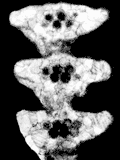 Abstract: The taxonomic classification and mutual distinction of the genera Physoporella Steinmann and Oligoporella Pia (Dasycladales, green algae) have proven problematic and that has impeded their use in stratigraphy and other studies. The presence of single whorls of piriform laterals in Physoporella and double whorls in Oligoporella is considered as the main characteristic that separates these genera. According to that, diagnoses of genera and all species and varieties are changed or supplemented, and detailed descriptions are given. For this purpose the type-material from Pia's collection was re-examined and its redocumentation and reinterpretation performed. Additional information was obtained from abundant material from Croatia (Ivančica Mt, Medvednica Mt, umberak Mt, Lika, Dalmatia). Only a few taxa were examined based on literature data. For all species and varieties reconstructions are given. Taxa from the Permian of East Asia are only briefly described. Among the investigated taxa, some of them have a structure that significantly differs from that present in the type species of the genera Physoporella and Oligoporella. They are separated into two new genera Ardeiporella and Neophysoporella. The revised genera Physoporella and Oligoporella, together with the newly established ones, give a clearer picture of phylogenetic relations. Abstract: The taxonomic classification and mutual distinction of the genera Physoporella Steinmann and Oligoporella Pia (Dasycladales, green algae) have proven problematic and that has impeded their use in stratigraphy and other studies. The presence of single whorls of piriform laterals in Physoporella and double whorls in Oligoporella is considered as the main characteristic that separates these genera. According to that, diagnoses of genera and all species and varieties are changed or supplemented, and detailed descriptions are given. For this purpose the type-material from Pia's collection was re-examined and its redocumentation and reinterpretation performed. Additional information was obtained from abundant material from Croatia (Ivančica Mt, Medvednica Mt, umberak Mt, Lika, Dalmatia). Only a few taxa were examined based on literature data. For all species and varieties reconstructions are given. Taxa from the Permian of East Asia are only briefly described. Among the investigated taxa, some of them have a structure that significantly differs from that present in the type species of the genera Physoporella and Oligoporella. They are separated into two new genera Ardeiporella and Neophysoporella. The revised genera Physoporella and Oligoporella, together with the newly established ones, give a clearer picture of phylogenetic relations.
|
|
Carnets Geol., vol. 22, no. 7, p. 171-310
Online since June 4, 2022
|
|
The report of a rare deformed eagle ray (Myliobatiformes: Myliobatidae) tooth plate from the Neogene of Calvert Cliffs, Maryland, U.S.A.
Stephen J. GODFREY, David J. BOHASKA & John MAISEY
| HTML  | PDF
| PDF  [937 KB]
| DOI: 10.2110/carnets.2022.2206 [937 KB]
| DOI: 10.2110/carnets.2022.2206
|
|
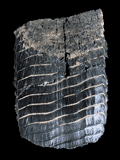 Abstract: An isolated and deformed
lower tooth plate of an eagle ray (Aetomylaeus
sp., Myliobatidae, Myliobatiformes) is reported herein from the Miocene deposits
along Calvert Cliffs, Maryland, U.S.A. Deformed myliobatid tooth plates like
this, either fossil or modern, are exceedingly rare. All medial teeth are
deformed/skewed such that the right side of each tooth forms an angle of about
10 degrees to the transverse axis of the dental plate. The skewed abnormal form
of the teeth in USNM PAL 726325
is not thought to be the result of modern or taphonomic deformation. Rather, the
deformity exhibited by USNM PAL 726325
gives every indication that successive similarly deformed teeth came about as a
result of a persistent anatomical deformity of the dental lamina. From the
consistency in the deformed shape of each tooth, it would appear as though the
dental lamina retained this anomalous shape at least throughout the time
represented by the age of the tooth plate. If this interpretation is correct,
the deformity was not fatal and did not significantly impair the functionality
of the tooth pavement over a protracted part (or all) of the individual's life
span. Abstract: An isolated and deformed
lower tooth plate of an eagle ray (Aetomylaeus
sp., Myliobatidae, Myliobatiformes) is reported herein from the Miocene deposits
along Calvert Cliffs, Maryland, U.S.A. Deformed myliobatid tooth plates like
this, either fossil or modern, are exceedingly rare. All medial teeth are
deformed/skewed such that the right side of each tooth forms an angle of about
10 degrees to the transverse axis of the dental plate. The skewed abnormal form
of the teeth in USNM PAL 726325
is not thought to be the result of modern or taphonomic deformation. Rather, the
deformity exhibited by USNM PAL 726325
gives every indication that successive similarly deformed teeth came about as a
result of a persistent anatomical deformity of the dental lamina. From the
consistency in the deformed shape of each tooth, it would appear as though the
dental lamina retained this anomalous shape at least throughout the time
represented by the age of the tooth plate. If this interpretation is correct,
the deformity was not fatal and did not significantly impair the functionality
of the tooth pavement over a protracted part (or all) of the individual's life
span.
|
|
Carnets Geol., vol. 22, no. 6, p. 161-169
Online since May 10, 2022
|
|
The Kalkowsky Project - Chapter III. Significance of primary radial fabrics associated with ancient partly leached or recrystallized calcareous ooids
Bruno R.C. GRANIER & Philippe LAPOINTE
| HTML  | PDF
| PDF  [1,851 KB]
| DOI: 10.2110/carnets.2022.2205 [1,851 KB]
| DOI: 10.2110/carnets.2022.2205
|
|
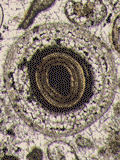 Abstract: Calcitic ooids and bothryoids from
the Yacoraite Formation in the provinces of Jujuy and Salta (Argentina) display
radial fabrics pointing to their primarily high-Mg calcite (HMC) nature. The
present publication documents some specimens that are partly or fully leached
or recrystallized, which raises fundamental questions about the validity of
some concepts, such as the very existence of the so-called "two-phase"/"bimineralic"
ooids. It is assumed here that the organic content in the oolitic cortices
(and, subsequently, its degree of oxidation) is the key to explaining some
differential diagenetic alterations. Abstract: Calcitic ooids and bothryoids from
the Yacoraite Formation in the provinces of Jujuy and Salta (Argentina) display
radial fabrics pointing to their primarily high-Mg calcite (HMC) nature. The
present publication documents some specimens that are partly or fully leached
or recrystallized, which raises fundamental questions about the validity of
some concepts, such as the very existence of the so-called "two-phase"/"bimineralic"
ooids. It is assumed here that the organic content in the oolitic cortices
(and, subsequently, its degree of oxidation) is the key to explaining some
differential diagenetic alterations.
|
|
Carnets Geol., vol. 22, no. 5, p. 149-160
Online since March 4, 2022
|
|
Adult morphologies of Puzosia quenstedti (Parona & Bonarelli, 1897) (Ammonoidea, Desmoceratidae) in the Albian of the South-East of France. Taxonomic implications
Jean-Louis Latil LATIL, Gérard DELANOY & Pierre DELATTRE
| HTML  | PDF
| PDF  [5,643 KB]
| DOI: 10.2110/carnets.2022.2204 [5,643 KB]
| DOI: 10.2110/carnets.2022.2204
|
|
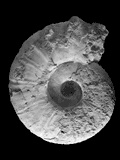 Abstract: Several adult specimens belonging to the genus Puzosia
Bayle, 1878, were collected in the Albian of Lieuche
(Alpes-Maritimes, France). Comparison with material from the condensed Albian levels of La Balme
de Rencurel (Isère, France), in particular those described and figured by Jacob
(1908), has highlighted a morphological link between the adult forms from
Lieuche and the incomplete specimens from the condensed levels of the Lower-Middle Albian of
south-eastern France and to identify them as Puzosia quenstedti (Parona
& Bonarelli, 1897).
These new details on the ontogenetic development of this species also allow new perspectives in
the taxonomic treatment of Albian Puzosia species. A modified diagnosis of Puzosia
quenstedti is proposed. Abstract: Several adult specimens belonging to the genus Puzosia
Bayle, 1878, were collected in the Albian of Lieuche
(Alpes-Maritimes, France). Comparison with material from the condensed Albian levels of La Balme
de Rencurel (Isère, France), in particular those described and figured by Jacob
(1908), has highlighted a morphological link between the adult forms from
Lieuche and the incomplete specimens from the condensed levels of the Lower-Middle Albian of
south-eastern France and to identify them as Puzosia quenstedti (Parona
& Bonarelli, 1897).
These new details on the ontogenetic development of this species also allow new perspectives in
the taxonomic treatment of Albian Puzosia species. A modified diagnosis of Puzosia
quenstedti is proposed.
The presence of Douvilleiceras sp. juv. aff. D. mammillatum (Schlotheim,
1813) in superimposed overlying levels allows assignation of a Lower Albian (Douvilleiceras
mammillatum Superzone) to a basal Middle Albian age (Hoplites dentatus Zone).
|
|
Carnets Geol., vol. 22, no. 4, p. 119-147
Online since February 28, 2022
|
|
The Kalkowsky Project - Chapter II. Wobbly ooids in a stromatolite from the Yacoraite Formation (Argentina)
Bruno R.C. GRANIER & Philippe LAPOINTE
| HTML  | PDF
| PDF  [1,375 KB]
| DOI: 10.2110/carnets.2022.2203 [1,375 KB]
| DOI: 10.2110/carnets.2022.2203
|
|
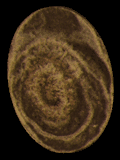 Abstract: Eccentric ooids are described from a brackish
Maastrichtian paleolake in NW Argentina. The first report of such atypical
coated grains was from marine Upper Jurassic strata in SE Poland. Because their
growth pattern is not likely to be confused with that of other
"eccentric" ooids, such as asymmetric ooids, hiatus ooids, half-moon
ooids, or "broken" ooids, it is suggested here to name them
"wobbly ooids". Abstract: Eccentric ooids are described from a brackish
Maastrichtian paleolake in NW Argentina. The first report of such atypical
coated grains was from marine Upper Jurassic strata in SE Poland. Because their
growth pattern is not likely to be confused with that of other
"eccentric" ooids, such as asymmetric ooids, hiatus ooids, half-moon
ooids, or "broken" ooids, it is suggested here to name them
"wobbly ooids".
|
|
Carnets Geol., vol. 22, no. 3, p. 111-117
Online since February 15, 2022
|
|
The genera Roloboceras Casey, 1954, and Megatyloceras Humphrey, 1949 (Ammonoidea, Ancyloceratina, Douvilleiceratidae), from the Lower Aptian of Ardèche (SE France) - Taxonomic and biostratigraphic implications
Gérard DELANOY, Cyril BAUDOUIN, Antoine PICTET, Josep MORENO-BEDMAR, Camille FRAU & Bertrand MATRION
| HTML  | PDF
| PDF  [11,947 KB]
| DOI: 10.2110/carnets.2022.2202 [11,947 KB]
| DOI: 10.2110/carnets.2022.2202
|
|
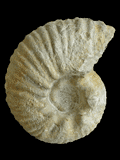 Abstract: The
Lower Aptian marine deposits from southern Ardèche (South-East of France) yield
a rich ammonite fauna of the sub-family Roloboceratinae Casey,
1961, which dates the upper Deshayesites
forbesi Zone (Roloboceras hambrovi
Subzone pro parte ?). The systematic study of this Roloboceratinae fauna
has improved our knowledge of Megatyloceras
coronatum Rouchadzé, 1933, type species of Megatyloceras Humphrey,
1949, as well as a better understanding of the genus thanks to the examination
of the species from the Anglo-Paris Basin. A new species, M.
leteilensis sp. nov. is introduced, and a description of M.
transiens Casey, 1961, provided, with clarifications on its possible
stratigraphic position. This study also establishes that the "species" Megatyloceras
ricordeanum (Orbigny, 1850) represents only a growth stage shared by
several species of Megatyloceras which is doubtfully a true taxon
and must, therefore, be considered as a nomen dubium.
The hypothesis of sexual dimorphism in Roloboceras
Casey, 1954, and Megatyloceras
is advanced. The study of this Roloboceratinae fauna highlights their
heterogeneous distribution throughout Lower Aptian deposits of Ardèche, showing
a direct correlation with bathymetric range. The biostratigraphical distribution
of both genera on the Languedoc platform shows that Roloboceras is
present from the uppermost C2 segment to the C4 segment of the stable
carbon-isotope record, while Megatyloceras is limited to the middle C4
segment up to the lowermost C6 segment. Both genera coexist during the C4
segment. Abstract: The
Lower Aptian marine deposits from southern Ardèche (South-East of France) yield
a rich ammonite fauna of the sub-family Roloboceratinae Casey,
1961, which dates the upper Deshayesites
forbesi Zone (Roloboceras hambrovi
Subzone pro parte ?). The systematic study of this Roloboceratinae fauna
has improved our knowledge of Megatyloceras
coronatum Rouchadzé, 1933, type species of Megatyloceras Humphrey,
1949, as well as a better understanding of the genus thanks to the examination
of the species from the Anglo-Paris Basin. A new species, M.
leteilensis sp. nov. is introduced, and a description of M.
transiens Casey, 1961, provided, with clarifications on its possible
stratigraphic position. This study also establishes that the "species" Megatyloceras
ricordeanum (Orbigny, 1850) represents only a growth stage shared by
several species of Megatyloceras which is doubtfully a true taxon
and must, therefore, be considered as a nomen dubium.
The hypothesis of sexual dimorphism in Roloboceras
Casey, 1954, and Megatyloceras
is advanced. The study of this Roloboceratinae fauna highlights their
heterogeneous distribution throughout Lower Aptian deposits of Ardèche, showing
a direct correlation with bathymetric range. The biostratigraphical distribution
of both genera on the Languedoc platform shows that Roloboceras is
present from the uppermost C2 segment to the C4 segment of the stable
carbon-isotope record, while Megatyloceras is limited to the middle C4
segment up to the lowermost C6 segment. Both genera coexist during the C4
segment.
|
|
Carnets Geol., vol. 22, no. 2, p. 7-109
Online since February 17, 2022
|
|
Nomenclatural Note, p.
110
|
|
Comments on a small sabretooth cat in the Abismo Ponta de Flecha Cave, Vale do Ribeira, southeastern Brazil
Artur CHAHUD
| HTML  | PDF
| PDF  [448 KB]
| DOI: 10.2110/carnets.2022.2201 [448 KB]
| DOI: 10.2110/carnets.2022.2201
|
|
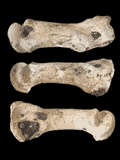 Abstract: Vale do Ribeira, in southeastern Brazil, is known for its many
caves that contain osteological material, including remains that have been
referred to several extinct species. The sabertooth cat Smilodon populator was a large predator that inhabited South America
during the Quaternary. A specimen that is represented in the Abismo Ponta de
Flecha Cave by small forelimb bones (metacarpals and phalanges) is commented
here. The metacarpals display morphological characteristics of S.
populator, but are smaller than those of S.
fatalis and larger than those of S.
gracilis. This specimen is amongst the smallest ever found specimen of S.
populator and is comparable in size to an adult lion. Abstract: Vale do Ribeira, in southeastern Brazil, is known for its many
caves that contain osteological material, including remains that have been
referred to several extinct species. The sabertooth cat Smilodon populator was a large predator that inhabited South America
during the Quaternary. A specimen that is represented in the Abismo Ponta de
Flecha Cave by small forelimb bones (metacarpals and phalanges) is commented
here. The metacarpals display morphological characteristics of S.
populator, but are smaller than those of S.
fatalis and larger than those of S.
gracilis. This specimen is amongst the smallest ever found specimen of S.
populator and is comparable in size to an adult lion.
|
|
Carnets Geol., vol. 22, no. 1, p. 1-6
Online since January 17, 2022
|
|
|
|